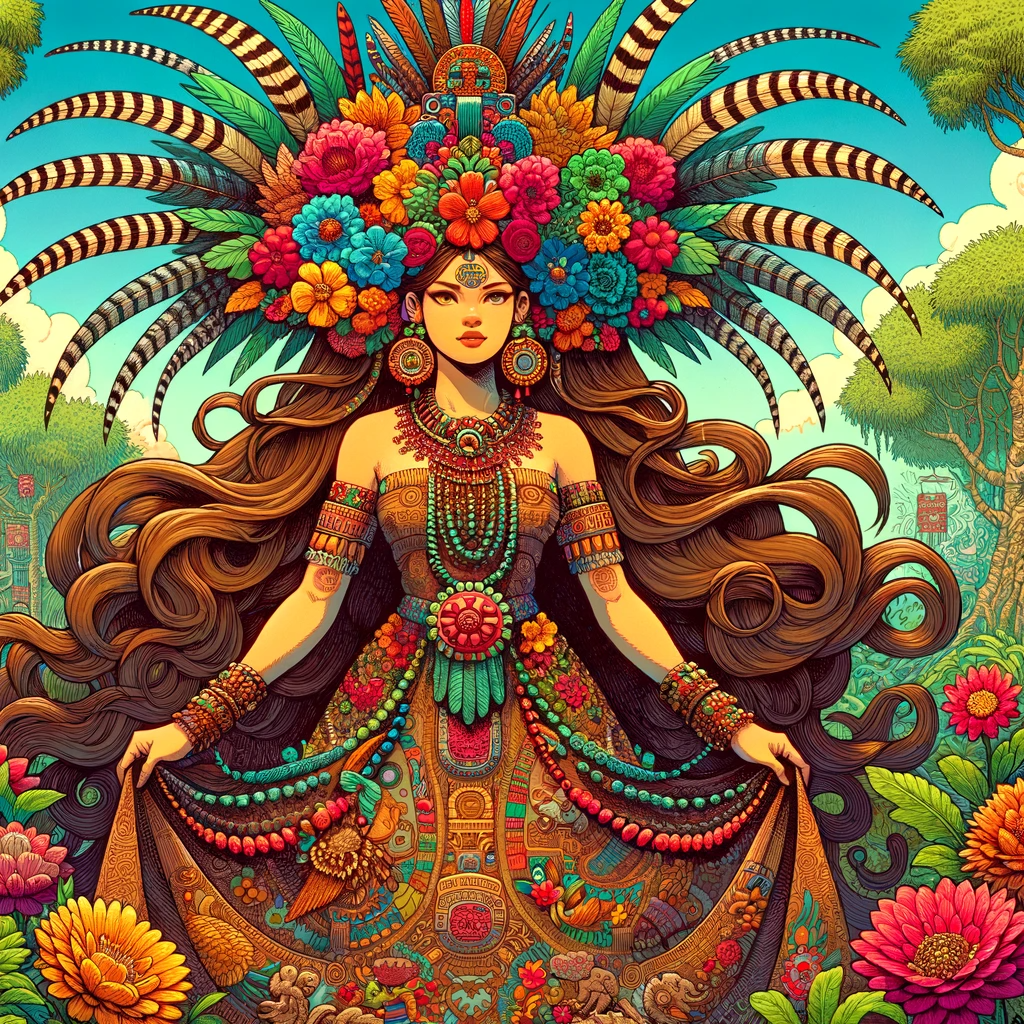
In the rich tapestry of Aztec mythology, few deities capture the imagination quite like Xochiquetzal (pronounced Sho-chee-ket-zal). This goddess, whose name translates to "Flower Feather," is a symbol of beauty, love, fertility, and the arts. She holds a special place in the Aztec pantheon as a patron of artists, women, and the crafts that beautify life.
Origins and Family
Xochiquetzal, a vibrant figure in Aztec legends, was believed to be the wife of Tlaloc, the rain god, before becoming the consort of Tezcatlipoca, the powerful god of night and sorcery. This transition in her marital status in myths reflects her significance and the diverse aspects of life she influenced.
Depiction and Symbols
Typically depicted as a young and enchanting woman, Xochiquetzal is adorned with rich garments and precious flowers, often surrounded by butterflies and birds, symbols of beauty and delicate strength. She carries a dual role as both a maiden and a mother, representing the cyclical nature of life.
Goddess of Weavers and Artists
Xochiquetzal's influence extended beyond mere beauty; she was the divine patron of weavers, artists, and craftsmen. Under her guidance, the Aztecs created stunning works of art, intricate textiles, and exquisite jewelry. Her presence was a creative spark, inspiring the creation of objects that were both functional and beautiful.
Role in Fertility and Childbirth
Xochiquetzal was not only a symbol of physical beauty but also fertility and childbirth. She provided protection to women during childbirth, a critical role in a society that placed high importance on family and the continuity of lineage.
Cultural Significance and Festivals
Her cult was particularly significant, with festivals dedicated to her that celebrated the joy and beauty she brought into the world. These festivals were occasions of great joy and artistic expression, involving dances, flower offerings, and artistic competitions.
Legacy and Modern Interpretation
Today, Xochiquetzal remains an enduring symbol of the fusion of beauty, art, and life's generative forces. She is often explored in scholarly works for her representation of the feminine divine and her role in Aztec society. Modern interpretations of Xochiquetzal also highlight her as a figure of female empowerment and creative inspiration.
Conclusion
Xochiquetzal, with her myriad roles and vibrant imagery, is a captivating figure in Aztec mythology. She exemplifies the Aztec appreciation for beauty, art, and the essential aspects of life that make it worth living. Her legacy continues to inspire and intrigue people around the world, a testament to the enduring power of myth and symbol in human culture.
Origins and Family
Xochiquetzal, a vibrant figure in Aztec legends, was believed to be the wife of Tlaloc, the rain god, before becoming the consort of Tezcatlipoca, the powerful god of night and sorcery. This transition in her marital status in myths reflects her significance and the diverse aspects of life she influenced.
Depiction and Symbols
Typically depicted as a young and enchanting woman, Xochiquetzal is adorned with rich garments and precious flowers, often surrounded by butterflies and birds, symbols of beauty and delicate strength. She carries a dual role as both a maiden and a mother, representing the cyclical nature of life.
Goddess of Weavers and Artists
Xochiquetzal's influence extended beyond mere beauty; she was the divine patron of weavers, artists, and craftsmen. Under her guidance, the Aztecs created stunning works of art, intricate textiles, and exquisite jewelry. Her presence was a creative spark, inspiring the creation of objects that were both functional and beautiful.
Role in Fertility and Childbirth
Xochiquetzal was not only a symbol of physical beauty but also fertility and childbirth. She provided protection to women during childbirth, a critical role in a society that placed high importance on family and the continuity of lineage.
Cultural Significance and Festivals
Her cult was particularly significant, with festivals dedicated to her that celebrated the joy and beauty she brought into the world. These festivals were occasions of great joy and artistic expression, involving dances, flower offerings, and artistic competitions.
Legacy and Modern Interpretation
Today, Xochiquetzal remains an enduring symbol of the fusion of beauty, art, and life's generative forces. She is often explored in scholarly works for her representation of the feminine divine and her role in Aztec society. Modern interpretations of Xochiquetzal also highlight her as a figure of female empowerment and creative inspiration.
Conclusion
Xochiquetzal, with her myriad roles and vibrant imagery, is a captivating figure in Aztec mythology. She exemplifies the Aztec appreciation for beauty, art, and the essential aspects of life that make it worth living. Her legacy continues to inspire and intrigue people around the world, a testament to the enduring power of myth and symbol in human culture.